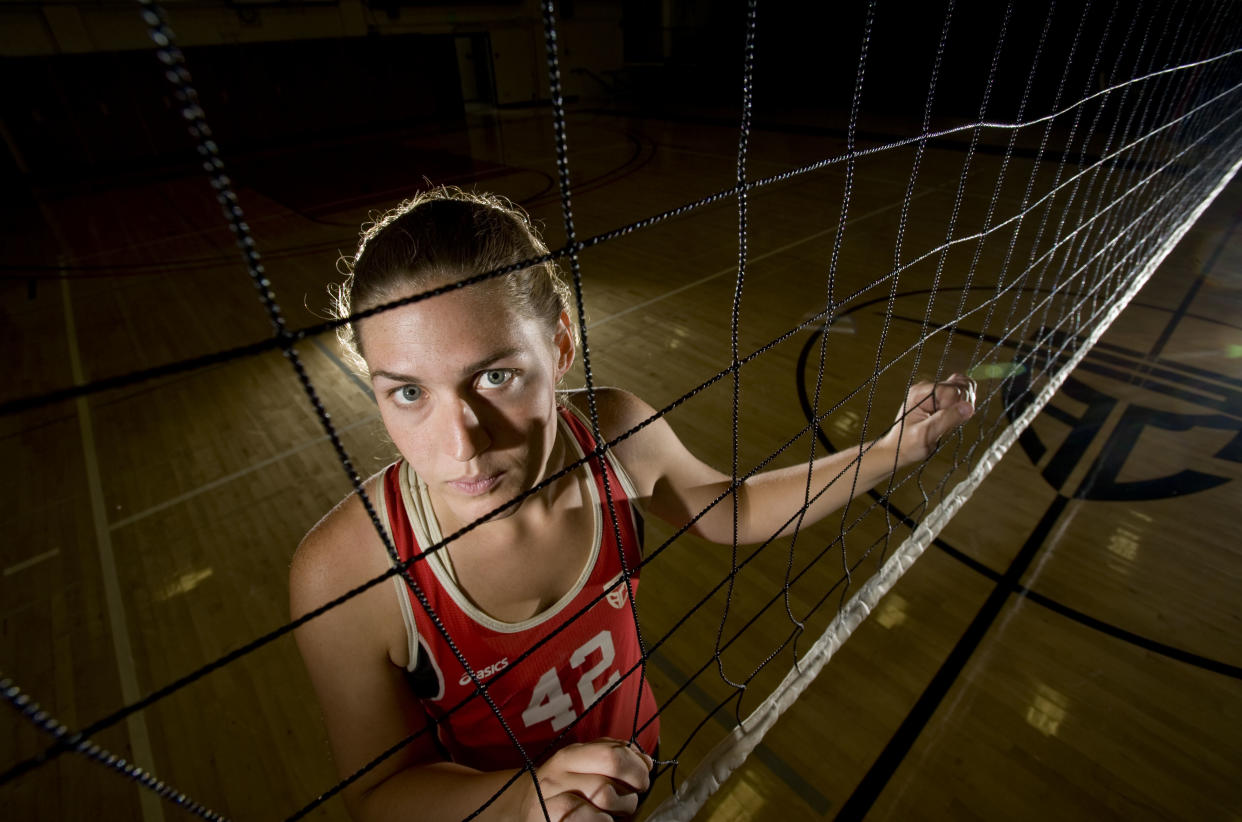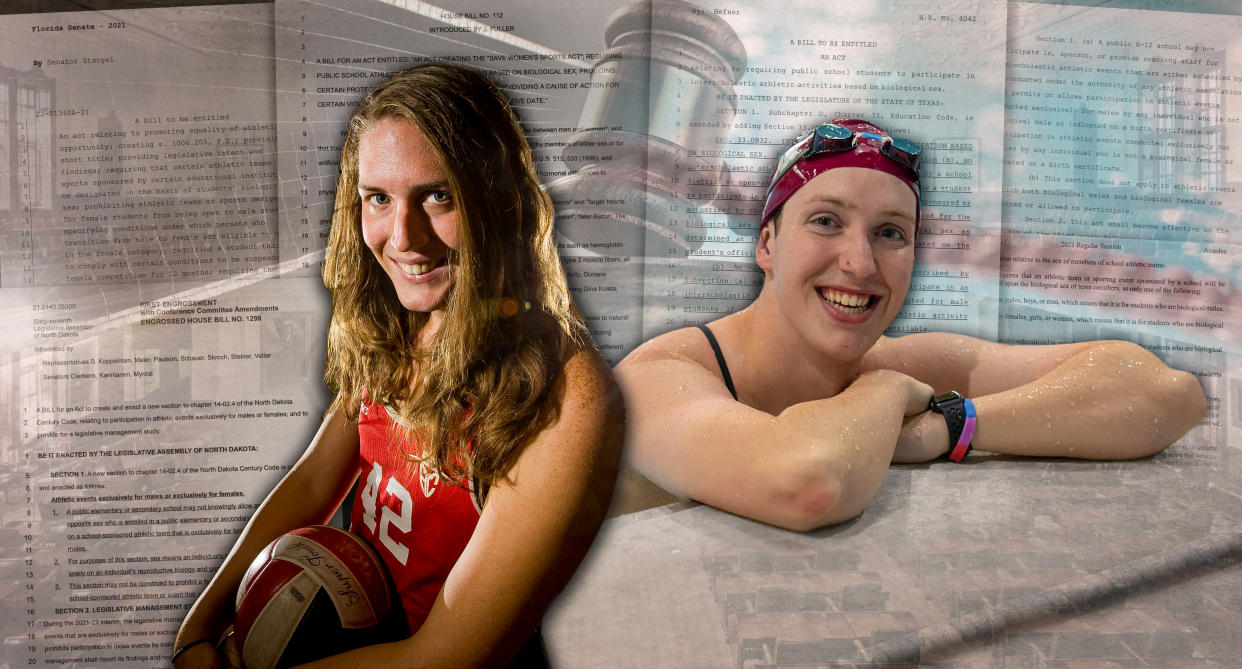Trans athletes open up about the fight for their existence
When state lawmakers in Kansas began their two-hour policy debate on Senate Bill 208, Layshia Clarendon didn’t run to the nearest computer and try to find a livestream of the event. She didn’t search for headlines, where the stories would’ve included vitriolic references to “biological boys,” “natural-born females” and even a nod to “old-fashioned chivalry.”
That wasn’t happening. Not on this day.
“I don’t engage with the everyday. It’s too hard,” said Clarendon, a guard with the New York Liberty. “I’ve had to protect myself. These people are having a debate about my existence; I can’t digest that.”
'Build-A-Bear' bills
Over the past several months, politicians from Montana to Mississippi have filed a record number of bills aimed at restricting transgender women and girls from playing on women's sports teams. The coordinated drumbeat has been incessant and loud. This year, lawmakers in more than 20 states have introduced legislation that would ban transgender athletes from playing on teams that align with their gender identities. Laws have already passed in Mississippi, Arkansas and Tennessee.
Athletes and advocates alike have responded with a combination of outrage, concern and an undeniable sense of purpose. As Clarendon, the WNBA's first nonbinary, openly transgender athlete, puts it: Not on my watch.
“It’s just the next political stake in the ground, the next political issue to divide us,” said Clarendon, who uses she/her/they/them/he/him pronouns. “They just want to push an agenda. It’s all for political gain to keep people oppressed. ... So much of this has been done under the radar with COVID. It’s heartbreaking and really gross.”
The spate of proposals — Clarendon calls them "Build-A-Bear" bills because of the interchangeable language they often use — all run counter to an executive order President Joe Biden signed on his first day in office. That order is aimed at prohibiting discrimination on the basis of gender or sexual orientation. Before the ink was dry, #BidenErasedWomen began trending on Twitter.
Supporters of the bills argue they’re protecting girls and women. They claim opportunities to compete are being stolen by transgender athletes who pose a threat to roster spots and college scholarships because of an unfair physical advantage. All this, proponents assert, will be the death knell of women’s sports.
Trans athletes share their stories
Members of the transgender community have one word for that: Nonsense.
“They clearly didn’t see me play sports,” former volleyball player Chloe Anderson said with a laugh. “I was last in everything.”
Anderson became one of the first transgender athletes to play women’s volleyball at the Division III level when she joined the team at UC Santa Cruz in 2016. It was a significant step forward in a difficult, deeply personal journey.
Ask Anderson when she first began to question her gender identity, and you’ll hear warm mentions of childhood memories involving princess outfits and games with girls. Then tales turn to schoolyard bullying, depression and detachment as a young Anderson grappled with something she was unable to identify much less articulate.
She didn’t have a name for it until her junior year at Irvine High School, when a discussion about transgender kids during her psychology class led to an epiphany:
Oh, so that’s what it’s called. This is what I’ve been feeling.

Through it all, volleyball was a source of motivation and an escape of sorts when everything else was so hard.
“It was one of the few things I was proud of,” Anderson said. “Volleyball was the only outlet I had that made me feel OK … It was a way for me to channel negative energies in a way that was more positive. It drove me to do well and meant so much to me.”
Anderson began transitioning after graduating from high school. She saw an endocrinologist at 19 and began a regimen of hormone treatments at 20. By the time she arrived at UC Santa Cruz, Anderson was well in adherence with NCAA rules, which require transgender women to undergo at least one year of hormone-suppression treatment before joining a women’s team (the International Olympic Committee also has well-established policies when it comes to transgender athletes).
The changes were subtle at first. She’d be a half-second late on her approach to the net, then a full second. Everything felt sluggish and slow. The explosiveness she once had? That “was not happening.” Soon her vertical leap began to fade, and before long, the athlete who could dunk a basketball could barely touch the rim.
“Any advantage people worry about,” Anderson said, “was pretty much gone after one year of hormones.”
Former Southern Illinois swimmer Natalie Fahey shares a similar experience. She began hormone replacement therapy during her junior year with the Salukis and remembers her strength and endurance fading as the months ticked by. Fahey followed a deliberate timeline — the “path of least pain,” she calls it — that allowed her to continue competing with the men while zeroing in on her ultimate goal: Swimming in one meet with the women before the end of her collegiate career.
Fahey accomplished that feat at the 2019 Missouri Valley Conference Swimming and Diving Championships where she was entered as an exhibition swimmer. When she walked the pool deck at the Mizzou Aquatic Center ahead of the 1,650-yard freestyle, her final event, the familiar chords of “Best Day of My Life” by American Authors rang through the speakers.
“A bit poetic,” she said.

Lawmakers have yet to provide rationale
Looking back at her time in the pool, Fahey shakes her head at questions of fairness, as both unproven by research and flatly unjust. And then she points to one of the greatest swimmers of all time.
With his vast wingspan and double-jointed ankles, 23-time Olympic gold medalist Michael Phelps boasts the ideal physique for swimming. Yet he’s lauded for his dominance, not chastised by those left in his frothy wake for some improper advantage.
“I don’t see anybody legislating away double-jointed knees and a large wingspan because they have an advantage,” said Fahey, who is reportedly the first male-to-female swimmer to compete on a Division I team. “It’s the same argument. How is that any different?
“There’s an inherent unfairness to life in general. The vast majority of trans athletes are just trying to compete. They’re trying to have fun and get what most athletes get out of sports. Camaraderie, the regimen that sports offers, the benefits of physical activity. There’s never any nefarious intent.”
Reporters from the Associated Press recently reached out to two dozen state lawmakers behind the rash of bills and found “only a few times [participation has] been an issue among the hundreds of thousands of American teenagers who play high school sports.”
No politician interviewed was able to cite a specific example within his or her own state where a problem existed. Some pointed to the future, citing what could be, rather than what was. Others turned to the oft-cited Connecticut case of transgender sprinters Terry Miller and Andraya Yearwood, whose success in high school track prompted a heated debate and high-profile lawsuit.
“It’s their Exhibit A, and there’s no Exhibit B — absolutely none,” Shannon Minter, legal director at the National Center for Lesbian Rights, told AP.
Former President Donald Trump took direct aim at transgender athletes when he returned to the national stage at the Conservative Political Action Conference in Orlando, Fla., in February.
"A lot of new records are being broken in women's sports — hate to say that, ladies — but got a lot of new records that are being shattered,” he said. “The records that stood for years, even decades, are now being smashed with ease. If this does not change, women’s sports as we know it, will die. It’ll end."
Trump made a vague reference to weightlifting while pretending to hoist a barbell, but if he had concrete examples, he didn’t share them.
“There’s this myth and this fear of trans people dominating in sports, but there’s just no evidence of that,” Clarendon said. “I hope it happens because we’re magical and amazing, but it’s not the case right now. Opportunities aren’t being turned away. That’s what’s infuriating. It’s just not happening.”
What is happening, advocates say, is anti-transgender fear-mongering on an unprecedented scale. It’s one more attack against a marginalized group already vulnerable to discrimination.
“Imagine if someone were to tell you that who you are shouldn’t exist. That your identity is completely meaningless,” Human Rights Campaign president Alphonso David told USA Today. “What I’m asking people to do is see beyond themselves and put themselves in the shoes of transgender youth who are being told by legislators that they don’t exist, that they’re second class, and imagine the impact that has on their mental health.”
Anderson concedes her experience at UC Santa Cruz was fraught. She felt isolated and at times as though the weight of the entire transgender community was on her shoulders. But as she watches lawmakers continue to threaten athletes with absolute bans, she knows her time on the court meant something.
“Even though it was hard, I still got to play and experience it,” she said. “A lot of my identity revolves around being a trans athlete. We all need to be heard so we can be part of the collaborative process to make it better. … It’s good to celebrate the positive, but it’s also good to acknowledge the difficulty. The truth is it’s been a battle the whole time, and it’s not over.”
Last month, more than 500 college athletes from nearly 100 universities signed a letter demanding the NCAA refuse to schedule championships in states that have banned transgender participation in sports.
“All athletes deserve to compete. All athletes are worthy of protection. No athlete should feel unsafe being who they are,” the letter read in part.
When Fahey looks back at her experience at Southern Illinois, her only regret is not transitioning sooner. She was supported and accepted both by her teammates and her coaches. When she came out to former swimming coach Rick Walker, his response was just what Fahey needed to hear.
“If this is who you are, you’re welcome here.”
But Fahey readily admits being transgender and a swimmer presented a “unique struggle.” Swimming by nature is an extremely visible sport; there is no hiding in a swimsuit. When Fahey began to wear women’s swimsuits because of breast development, she became instantly more visible — and vulnerable.
Initially, she had to work up the nerve just to leave the locker room.
“The period of transition is generally very private time in terms of your body,” Fahey said. “There’s this desire to close up in a cocoon to see the changes for yourself before going out and meeting people. To be forced every day to only wear a swimsuit …
It helps remind myself that I’m a pretty damn strong woman.”
Clarendon summoned similar strength on Jan. 29 when she took a deep breath, swallowed her fears and revealed on social media that she’d undergone top surgery. Declaring “freedom at last,” Clarendon posted images of her chest after the procedure and was quickly met with overwhelming support from across the WNBA. Sue Bird, Elena Delle Donne and Brittney Griner all expressed their admiration and respect.
Three months after surgery, Clarendon says she feels “amazing” and “gender-full.”
“I’ve found it very cathartic and healing to be so open and free,” Clarendon said. “This is who I am, and I feel really good about it. I feel whole and at peace in a lot of ways.”
Clarendon is intent to keep fighting until all athletes can share in that freedom. To the transgender minors sitting in the path of a torrent of legislation, she says this: “I’m sorry adults are failing you, but know we’re fighting our asses off. Know your existence is valued.”
